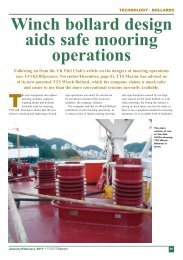Create successful ePaper yourself
Turn your PDF publications into a flip-book with our unique Google optimized e-Paper software.
JUNE <strong>2003</strong><br />
<strong>TTS</strong> <strong>Review</strong><br />
Kaisuu, Belgium´s leading dredging operator Jan de Nul´s<br />
trailing suction hopper dredger has electro-hydraulic deck<br />
cranes designed and supplied by <strong>TTS</strong> Marine Cranes AS.<br />
Read more on “Specialised cranes for Jan de Nul” on page 14.
Table of Contents<br />
3 Hatch covers and bearing pads for China Shipping’s<br />
new containership fleet renewal programme<br />
4 Large stern ramp/door provides just what<br />
Boeing needs for its Delta IV EELV rocket programme<br />
6 Comprehensive cargo access equipment package for Visby<br />
– China’s first Ro-Pax newbuilding for European owners<br />
7 <strong>TTS</strong> Ships Equipment expands worldwide service<br />
network with co-operation agreement with Goltens<br />
8 Maersk Waterford – first of two feeder containerships<br />
to feature <strong>TTS</strong> turnkey supply of folding hatch covers<br />
9 Super Yacht Pelorus features the world’s largest<br />
stern bathing/mooring platform<br />
10 <strong>TTS</strong> wins side loading contract for<br />
Spliethoff’s Polish newbuildings<br />
12 <strong>TTS</strong> Ships Equipment’s IPSI and INTEGRATION projects<br />
lead to designs for enhanced ro-ro cargo handling operations<br />
13 <strong>TTS</strong> hose handling crane for Panamax<br />
tanker conversion in China<br />
14 Specialised cranes for Jan de Nul<br />
dredgers building in Spain<br />
15 Myklebust Mek Verksted OSV newbuilding for Østensjø<br />
features 100 ton capacity <strong>TTS</strong> crane<br />
16 New deck gear takes up the<br />
strain offshore<br />
17 Specialised buoy-handling crane for multi-purpose<br />
Middle East Lights Tender<br />
18 <strong>TTS</strong> transfer system for new<br />
Indian Navy base<br />
19 Specialised systems for handling sub-sea umbilicals and<br />
cables delivered by <strong>TTS</strong>
<strong>TTS</strong> <strong>Review</strong> June <strong>2003</strong> 3<br />
Hatch covers and bearing pads<br />
for China Shipping’s new containership fleet<br />
renewal programme<br />
Both vessels spearhead the<br />
major eight-ship,<br />
70,000dwt fleet renewal<br />
programme currently<br />
underway by China<br />
Shipping and feature hatch<br />
covers designed and<br />
supplied by <strong>TTS</strong> Ships Equipment’s Bremen,<br />
Germany and Shanghai, China companies,<br />
<strong>TTS</strong> Ships Equipment GmbH and <strong>TTS</strong> Hua<br />
Hai Ships Equipment Co Ltd.<br />
New Pudong was built by China’s<br />
Hudong-Zhonghua Shipbuilding (Yard No.<br />
H1263A), while New Dalian was built by<br />
Dalian New Shipbuilding Heavy Industries<br />
Co Ltd (Yard No. C5600-1). Both vessels,<br />
the largest of their type yet built by the<br />
respective shipyards, feature <strong>TTS</strong> designed<br />
lift-on/lift-off pontoon hatch covers designed<br />
for non-sequential opening/closing.The<br />
hatch cover panels are designed for lifting by<br />
shore-side cranes and can be stacked either<br />
on adjacent covers or ashore.The hatch<br />
covers are so arranged that longitudinal joints<br />
between the panels align with spaces between<br />
the containers on deck and in the holds.<br />
A total of 44 hatch cover panels have been<br />
supplied to each China Shipping<br />
newbuilding, covering a total day-opening<br />
area of 6,364m2 .Hatch No.1 is fitted with<br />
two panels (12.6m x 15.74m), hatch No.2<br />
with three panels (12.6m x 25.89m), hatch<br />
No.3 with three panels (12.6m x 30.96m),<br />
while hatch No. 4-15 have three panels<br />
(12.6m x 36.04m).<br />
The hatch covers are designed for a<br />
uniformly distributed load of <strong>1.</strong>3 ton/m2 B<br />
for<br />
hatch covers of Hold No. 1-4, and<br />
<strong>1.</strong>05 ton/m 2 for the covers of Hold<br />
No. 5-15. Each hatch cover is sufficiently<br />
strengthened for a container stack load<br />
of 90 tonnes for a maximum of six tiers<br />
of 20ft containers per stack, or 120 tonnes<br />
per six tires of 40ft container per stack.<br />
45ft containers can be loaded from the<br />
third top tier of 40ft containers on<br />
Hatch No. 3,5,9,12 and 15, while 45ft<br />
containers can also be loaded from the first<br />
tier on the hatch covers for Hatch No.1,7<br />
and 1<strong>1.</strong><br />
Both China Shipping vessels also feature<br />
<strong>TTS</strong> Ships Equipment’s unique, patented,<br />
OptiPad hatch cover bearing pad design,<br />
part of the company’s EverEst range of<br />
new generation hatch cover bearing pads<br />
incorporating advanced technology<br />
materials.The OptiPad design is made of<br />
PTFE in the form of a ‘weave’ fabric, which<br />
results in a highly effective bearing pad able<br />
to absorb very high loadings while<br />
accommodating considerable movement of<br />
the hatch cover/coaming interface.<br />
The start of <strong>2003</strong> has been a busy one for<br />
<strong>TTS</strong> Ships Equipment GmbH in Bremen and<br />
<strong>TTS</strong> Hua Hai Ships Equipment Co Ltd in<br />
Shanghai with ship deliveries.<br />
Besides the two large containerships for<br />
China Shipping, a further six <strong>TTS</strong> hatch<br />
cover-equipped vessels have been delivered<br />
by Chinese shipyards:<br />
• BBC Europe, 7,000dwt multipurpose<br />
cargoship from Xingang Shipyard (Hull<br />
No. SB325) for Germany’s Brise<br />
Schiffahrts – <strong>TTS</strong> hydraulic, multi-folding,<br />
pontoon hatch covers<br />
Two of the largest<br />
containerships yet built in<br />
China have recently been<br />
handed over to China<br />
Shipping, the 5668 TEU pair<br />
New Pudong and New Dalian.<br />
• IVS Viking, 32,500dwt bulk carrier from<br />
Xingang Shipyard (Hull No. SB333) for<br />
Denmark’s Clipper Elite Carriers – <strong>TTS</strong><br />
hydraulic, folding hatch covers<br />
• Vega Diamond, 1,100 TEU capacity<br />
containership from Jinling Shipyard (Hull<br />
No. JLZ01-0103) for Germany’s Carsten<br />
Rehderi – <strong>TTS</strong> lift-on/lift-off hatch covers<br />
• Annette, 25,500dwt bulk carrier from<br />
Jiangsu Yangzijiang Shipbuilding Co Ltd<br />
(Hull No.YZJ99-599C28) for Germany’s<br />
MST GmbH – <strong>TTS</strong> hydraulic, folding<br />
hatch covers<br />
• Pac Palawan, 6,500dwt multi-purpose<br />
cargoship from Jiangsu Yangzijiang<br />
Shipbuilding Co Ltd (Hull No.YZJ2001-<br />
640C43) for Singapore’s Pacific Carriers<br />
– <strong>TTS</strong> lift-on/lift-off hatch covers<br />
• Asian Trade, 1,100 TEU capacity<br />
containership from Jiangdong Shipyard<br />
(Hull No. JD1100TEU-2) for Germany’s<br />
W. Bockstigel Shipping – <strong>TTS</strong> lift-on/liftoff<br />
hatch covers<br />
China has become an important country<br />
for <strong>TTS</strong> Ships Equipment and the scope<br />
of supply of hatch covers outlined above<br />
highlights this.With its own dedicated<br />
operation in China,<strong>TTS</strong> Hua Hai Ships<br />
Equipment Co Ltd, in Shanghai (a 50:50<br />
joint venture between China State<br />
Shipbuilding Corp and <strong>TTS</strong> Ships Equipment<br />
AB),<strong>TTS</strong> is able to meet the needs for all<br />
dry cargo handling systems requirements for<br />
newbuilding under construction at Chinese<br />
shipyards locally, backed-up by the hatch<br />
cover ‘Centre of Excellence’ of the group in<br />
Bremen, Germany and the ro-ro ‘Centre of<br />
Excellence’ in Gothenburg, Sweden.
4 <strong>TTS</strong> <strong>Review</strong> June <strong>2003</strong><br />
Large stern ramp/door provides just<br />
what Boeing needs for its Delta IV EELV<br />
rocket programme<br />
The ‘Ro-Ro Centre of Excellence’ within <strong>TTS</strong> Ships Equipment, Gothenburg-based <strong>TTS</strong> Ships<br />
Equipment AB is not just designing cargo access systems for freight and passenger ferries and<br />
PCTCs, but is often asked to come up with cargo access solutions for some interesting designs<br />
of specialised ro-ro vessels.
One such vessel is<br />
8,680grt ro-ro<br />
Delta Mariner<br />
built by Moss<br />
Point yard of US<br />
shipbuilder VT Halter (Hull No.<br />
1835) for Seattle-based operator<br />
Foss Maritime.The unusual<br />
nature of this vessel is that she<br />
was purpose-built to carry<br />
Boeing’s new Delta IV rocket,<br />
hence her ro-ro access demanded<br />
somewhat specialised attention.<br />
The 94.5m long ro-ro is<br />
equipped with one large, single<br />
<strong>TTS</strong> designed stern ramp door<br />
over which the Delta IV rocket<br />
is loaded via a Kamag<br />
transporter. A special feature of<br />
this vessel’s design is that <strong>TTS</strong><br />
was also responsible for<br />
designing and supplying a special<br />
frame/coaming to fit the aft end<br />
of Delta Mariner.This frame/<br />
coaming forms a watertight<br />
closure together with the stern<br />
ramp/door. All rubber seals and<br />
packing channels, locking<br />
devices and brackets for hinges<br />
and cylinders are fitted to the<br />
frame prior to shipment to the<br />
shipyard, thereby reducing the<br />
construction time of the vessel.<br />
The frame is designed to fit the<br />
clear opening of the stern door,<br />
with approximately 900mm<br />
steel structure around the<br />
opening.<br />
<strong>TTS</strong> is now supplying<br />
specialised frame/coamings to<br />
a number of ro-ro newbuilding<br />
projects around the world,<br />
thereby assisting both the shipyard<br />
and the shipowner in saving time<br />
during new construction.<br />
Delta Mariner’s stern<br />
ramp/door is operated by a<br />
hydraulic cylinder arrangement,<br />
with the ramp/door hinged to<br />
the ship at main deck level.The<br />
ramp/door has a length of<br />
12.34m and a driveway breadth<br />
of 19.5m and is rated for a<br />
15.2 ton FLT, a 9.1 ton trailer<br />
or a 12.6 ton Kamag<br />
transporter.The latter is used<br />
for the handling of the Boeing<br />
rockets.<br />
With the entering into service<br />
of Delta Mariner, the US Air<br />
Force is one step further closer<br />
to launching its first West Coast<br />
Evolved Expendable Launch<br />
Vehicle (EELV) mission, using<br />
the Delta IV rocket.The Delta<br />
IV fairing and common booster<br />
core (CBC), which includes the<br />
Rocketdyne RS-68 main engine,<br />
<strong>TTS</strong> <strong>Review</strong> June <strong>2003</strong> 5<br />
was recently transported aboard<br />
the Foss Maritime owned ro-ro<br />
from the Boeing rocket<br />
manufacturing plant in Decatur,<br />
Alabama to Space Launch<br />
Complex 6 at Vandenberg Air<br />
Force Base (VAFD) in California.<br />
While at VAFB the CBC will<br />
be mated with the second stage<br />
and launch-mate unit at the<br />
Horizontal Integration Facility,<br />
in preparation for the launch of<br />
a satellite for the USA’s National<br />
Reconnaissance Office.The<br />
mission, scheduled for the end<br />
of this year (<strong>2003</strong>) will be<br />
launched aboard a medium<br />
configuration of the vehicle that<br />
will include two solid rocket<br />
motors to supplement the first<br />
stage engine.<br />
Boeing is currently the only<br />
launch service provider that is<br />
conducting EELV missions from<br />
the US West Coast to meet US<br />
Air Force requirements.
6 <strong>TTS</strong> <strong>Review</strong> June <strong>2003</strong><br />
Comprehensive cargo access equipment package<br />
for Visby – China’s first Ro-Pax newbuilding<br />
for European owners<br />
Visby, the first of two large Ro-Pax newbuildings under construction in<br />
China for Swedish operator Rederi AB Gotland’s new high speed service<br />
to the island of Gotland in the Baltic has been delivered. Both vessels,<br />
which operate under the Swedish Government’s ‘Destination Gotland’<br />
service, feature an extensive supply of ro-ro access equipment designed<br />
and supplied by Gothenburg-based <strong>TTS</strong> Ships Equipment AB.<br />
Visby entered service between the<br />
Swedish mainland (Nynäshamn) and<br />
Visby, on the island of Gotland,<br />
towards the end of March this year<br />
and will be followed in August by a<br />
yet to be named sistership. Both vessels have been<br />
built by China’s Guangzhou Shipyard International<br />
Co Ltd, (Hull Nos 9130004/5) with Knud E.<br />
Hansen acting as the owners design consultants.<br />
Both Visby and her sistership are notable in<br />
a number of ways, bringing state-of-the-art ro-ro<br />
technology onto the vital social and economic link<br />
between the Swedish mainland and the island of<br />
Gotland, as well as being the first Ro-Pax’s to be<br />
built in China for European owners.<br />
<strong>TTS</strong> Ships Equipment’s contract for the two<br />
1,500 passenger capacity, 1,600 lane metre vessels<br />
comprised the design of a complete ship set of
cargo access equipment to meet<br />
the widely varying requirements<br />
of the owner’s service to<br />
Gotland, as well as the supply<br />
of parts and supervision of<br />
equipment installation.<br />
The traffic between the<br />
Swedish mainland and the island<br />
of Gotland fluctuates widely<br />
during the year. During the<br />
summer months 60% of the<br />
traffic is private cars and<br />
coaches, with freight traffic<br />
evenly distributed throughout<br />
the year.The cargo access<br />
equipment designed for the new<br />
ships reflects this.<br />
Both 195.80m long, 28,600grt<br />
ferries have been supplied with<br />
the following <strong>TTS</strong> Ships<br />
Equipment designed access<br />
equipment:<br />
• Three stern ramp/doors<br />
• Bow doors<br />
• Folding Frame<br />
• Side door/ramp<br />
• Pilot doors<br />
• Passenger doors<br />
Ro-ro traffic is carried on four<br />
decks; the lower two decks<br />
designed for cars and the upper<br />
two decks designed for freight<br />
trailers with a height of 4.9m.<br />
Cargo handling operations,<br />
via the stern, are highly flexible<br />
thanks to three separate<br />
ramp/doors.<br />
The smaller ramps, to port<br />
and starboard, are hinged to<br />
each vessels stern in way of two<br />
fixed ramps which lead from the<br />
main vehicle deck (Deck No.3,<br />
800 lane metres) up to the other<br />
vehicle deck (Deck No.5,<br />
800 lane metres). Each of these<br />
ramps is 22m long, with a<br />
driveway width of 4.2m.<br />
Meanwhile, a 15.4m long, 11m<br />
driveway width stern ramp/<br />
door provides direct access to<br />
each vessels main deck.<br />
Unique Folding Frame<br />
design provides bow access<br />
Forward on each vessel, a twosection<br />
bow door is hinged to<br />
the ships’ side structure.When<br />
in then open position the doors<br />
enable the unique, patented,<strong>TTS</strong><br />
Ships Equipment designed<br />
Folding Frame to be lowered to<br />
allow cargo loading/discharge<br />
operation.The 2<strong>1.</strong>5m long,<br />
6.2m driveway width Folding<br />
Frame, designed to meet the<br />
latest Stockholm Agreement<br />
stability rules, acts as a ramp in<br />
it down position and a door in<br />
its stowed position.<br />
At Deck No.5 level, forward<br />
on the port side, is located a side<br />
door/ramp.This 6.5m long,<br />
4.8m driveway width ramp<br />
allows for loading/discharge of<br />
vehicles via a shore-side ramp.<br />
The 28.5 knot Visby and her<br />
sistership bring state-of-the-art<br />
ro-ro technology to the vital<br />
passenger shipping link between<br />
the island of Gotland and the<br />
Swedish mainland, reducing the<br />
crossing time on this service<br />
from 4hrs 45mins to just 3hrs<br />
15mins. Gothenburg-based <strong>TTS</strong><br />
Ships Equipment AB’s expertise<br />
in the design of tailor-made<br />
solutions to ro-ro operators<br />
exacting requirements are ably<br />
demonstrated in these two new<br />
ships.<br />
<strong>TTS</strong> <strong>Review</strong> June <strong>2003</strong> 7<br />
<strong>TTS</strong> Ships Equipment<br />
expands worldwide<br />
service network with<br />
co-operation<br />
agreement with Goltens<br />
The Dry Cargo Handling division of <strong>TTS</strong> has<br />
significantly expanded its worldwide service<br />
and spare parts network with a co-operation<br />
agreement with well known repair and<br />
maintenance specialist Goltens.<br />
The new agreement between <strong>TTS</strong> Ships<br />
Equipment and Goltens will see the latter<br />
acting as <strong>TTS</strong> Ships Equipment service stations<br />
in the following areas:<br />
• Rotterdam, The Netherlands<br />
• Dubai, United Arab Emirates<br />
• Bahrain<br />
• Jeddah, Saudi Arabia<br />
• Fujairah, United Arab Emirates<br />
• Mumbai, India<br />
In Rotterdam, Goltens will also act for <strong>TTS</strong><br />
Ships Equipment in the role as spare parts<br />
distributor. It is expected that further service<br />
stations, particularly in the Far East, will be<br />
added to the network later this year.<br />
Goltens is a major player in the shiprepair,<br />
maintenance and service market worldwide,<br />
being known particularly for diesel engine<br />
repairs and reconditioning work. The<br />
company’s Dubai operation, also Goltens<br />
headquarters, is heavily involved in ship and<br />
offshore conversion projects, steel repairs and<br />
has recently become involved in the<br />
shipbuilding market in the Arabian Gulf area.<br />
The co-operation between <strong>TTS</strong> Ships Equipment<br />
and Goltens will mean that shipowners and<br />
operators will be able to call on a global, fast,<br />
reliable, first-class service and spare parts<br />
operation, leading to reduced vessel downtime<br />
and ‘off-hire’ periods.
8 <strong>TTS</strong> <strong>Review</strong> June <strong>2003</strong><br />
Maersk Waterford – first of two feeder<br />
containerships to feature <strong>TTS</strong> turnkey supply<br />
of folding hatch covers<br />
M<br />
Maersk<br />
Waterford,<br />
the first of a<br />
two ship<br />
series of<br />
643 TEU capacity feeder<br />
containerships ordered by<br />
German operator Jüngerhans<br />
Reederei from domestic<br />
shipbuilder Detlef Hegeman<br />
Rolandswerft GmbH & Co KG,<br />
for charter to Maersk, has just<br />
entered service.<br />
Both 8,100dwt vessels (Hull<br />
Nos 200 and 201) feature<br />
folding hatch covers designed<br />
and supplied by <strong>TTS</strong> Ships<br />
Equipment GmbH under a<br />
turnkey contract involving the<br />
design, production and<br />
installation of the covers.The<br />
contract also included the design<br />
and supply of the hydraulic<br />
operating system for the hatch<br />
covers, comprising 850m of<br />
hydraulic piping, hydraulic<br />
cylinders and one hydraulic<br />
pump unit rated at 2 x 22 kW,<br />
2 x 50 l/min.<br />
The 126.8m long containerships<br />
features three cargo holds:<br />
Hatch No.1 (14.0m x 13.20)<br />
being equipped with one folding<br />
pair of covers, Hatch No.2<br />
(3<strong>1.</strong>45m x 15.89m) being<br />
equipped with two pairs of<br />
covers as is Hatch No. 3<br />
(3<strong>1.</strong>45m x 15.89m).The hatch<br />
covers are rated for a uniformly<br />
distributed load of <strong>1.</strong>75 t/m 2<br />
and a 20ft container load of<br />
45 tons (4-5 tiers) and 80 tons<br />
for 30ft, 40ft and 45ft<br />
containers (4-5 tiers).
Super Yacht Pelorus features the world’s largest<br />
stern bathing/mooring platform<br />
I<br />
It’s now over three years since<br />
<strong>TTS</strong> Ships Equipment GmbH in<br />
Bremen, Germany diversified from<br />
its traditional market, that of<br />
commercial merchant ships, into<br />
the highly specialised Super Yacht<br />
market.With the successful delivery<br />
of two major newbuildings now<br />
under its belt, the company has<br />
established itself has a major player in this<br />
highly demanding market.<br />
<strong>TTS</strong>’ first Super Yacht delivery was the<br />
97m length o.a. Carintia VII (Project<br />
Fabergé) at Germany’s Lürssen Werft (Hull<br />
No. 13618).This vessel was handed over last<br />
year.The company’s second delivery, earlier<br />
this year, was the 114m length o.a. Pelorus<br />
(Hull No. 13600) from Germany’s Kröger<br />
Werft (a subsidiary of Lürssen Weft).This<br />
vessel features a comprehensive supply of<br />
<strong>TTS</strong> designed access equipment, under a<br />
turnkey contract, comprising:<br />
• Six sea terraces, four on the starboard<br />
side and two on the port side, all<br />
bottom-hinged and varying in size<br />
from 3.1m x 2.5m to 6.2m x 2.5m<br />
• One top-hinged stern bulkhead<br />
(6.0m x 3.0m)<br />
• One stern platform<br />
(10.0m x 10.0m x 2.5m)<br />
• Two top-hinged boat doors<br />
(10.1m x 2.7m) for the deployment of<br />
a wide variety of leisure craft carried<br />
onboard<br />
• 1 top-hinged jet-ski door<br />
(2.2m x <strong>1.</strong>8m)<br />
<strong>TTS</strong>’ contract also called for design and<br />
supply of the vessel’s complete low pressure<br />
hydraulic system to operate the above access<br />
equipment (hydraulic cylinders, pumps, PLC<br />
control etc).<br />
Unlike the company’s normal supply to<br />
commercial vessels, the demands placed on<br />
equipment suppliers to the Super Yacht<br />
market far exceeds that of merchant vessels,<br />
and, in some cases, naval vessels.Yards and<br />
owners insist on the highest quality in terms<br />
of design, equipment supply and outfitting.<br />
The systems involve an extremely high<br />
degree of engineering.<br />
With regard to the equipment supplied to<br />
Pelorus, all access equipment is actuated by<br />
hydraulic cylinders, with the hydraulic<br />
system being of the low pressure type<br />
(210 bar). All hydraulic pumps are equipped<br />
with noise and vibration suppression<br />
systems, allowing for extremely quiet<br />
operation, while a PLC system controls all<br />
operations.<br />
All access systems are designed with teak<br />
decking on top, with all piping and couplings<br />
being in stainless steel. In the closed position<br />
all access equipment is flush with the Super<br />
Yacht’s hull – there are no gaps between the<br />
shell openings and the ship’s structure!<br />
Weather-tightness is provided by single-lip<br />
seals against polished stainless steel counter<br />
plates.<br />
One notable feature about the <strong>TTS</strong><br />
equipment onboard Pelorus is that this<br />
Super Yacht is believed to feature the largest<br />
stern platform of any vessel of her type.This<br />
platform, with a length of 10m, a breadth of<br />
10m and a height of 2.5m, offers, in the<br />
<strong>TTS</strong> <strong>Review</strong> June <strong>2003</strong> 9<br />
open position, a large bathing area and<br />
berthing area for tenders. In the closed<br />
position, the stern platform blends<br />
seamlessly into the ship’s structure.<br />
<strong>TTS</strong> Ship Equipment GmbH also has an<br />
order for a third Super Yacht under<br />
construction in Germany, the 140m length<br />
o.a., 18.50m wide Le 120, due for delivery<br />
later this year.This vessel is being built<br />
jointly by Kröger Werft (hull) and Lürrsen<br />
(outfitting) and will feature a comprehensive<br />
supply of specially designed access doors:<br />
• Two stern doors<br />
• Two embarkation platform/doors<br />
• Two doors for passenger and crew<br />
access<br />
• Four boat doors<br />
• Two gangways<br />
With the booming Super Yacht newbuilding<br />
market (i.e. for vessels in excess of 50m<br />
length) seeing more and more larger vessels<br />
being ordered, the innovative skills of the<br />
<strong>TTS</strong> Ships Equipment have a receptive, high<br />
profile market.<br />
In breaking into the Super Yacht market,<br />
<strong>TTS</strong> Ships Equipment GmbH has show its<br />
ability to react and adapt quickly and<br />
innovatively to shipyards and shipowners<br />
changing cargo access equipment<br />
requirements, by providing access systems<br />
engineered to meet the fine, exacting<br />
requirements demanded of the Super Yacht<br />
market.
10 <strong>TTS</strong> <strong>Review</strong> June <strong>2003</strong><br />
<strong>TTS</strong> wins side loading contract<br />
for Spliethoff’s Polish newbuildings<br />
The signature product from Bergen-based <strong>TTS</strong> Ships Equipment AS is side loading systems<br />
for ships, technology which the company has a long track-record in.The system is particularly<br />
of benefit to reefer ship operations, pulp/paper carriers and coastal passenger/cargo ships<br />
and fishing trawlers.<br />
Following on from the delivery of the two 15,890dwt<br />
Taiwanese-built reefers Lombok Strait and Luzon<br />
Strait to Holland’s Seatrade Reefer Chartering by China<br />
Shipbuilding Corp (CSBC),<strong>TTS</strong> Ships Equipment AS in<br />
Bergen, Norway has secured another important contract<br />
for the design and delivery of side loading systems.<br />
The Taiwanese-built vessels, delivered towards the end of last year,<br />
are currently operating on the Dutch owner’s reefer fruit service<br />
from New Zealand to Northern Europe/UK. Each vessel has a<br />
capacity for 626,011ft2 F<br />
,providing underdeck capacity for about<br />
5,750 standard fruit pallets.Two 45 tonne capacity deck cranes are<br />
provided.They can also carry 440 TEU or 220 FEU on deck as well<br />
as 650 standard cars.<br />
Cargo holds are accessed via a <strong>TTS</strong> designed side-loading system,<br />
comprising four side doors each equipped with 12 tonne capacity<br />
pallet lifts.The side loading system allows for totally weather-free<br />
cargo handling operations.<br />
The latest newbuildings to feature <strong>TTS</strong>’ side-loading system design<br />
are the four multi purpose vessels on order at Poland’s Stocznia<br />
Szczcinska Nowa Shipyard (Hull Nos B 584-IV/5,6,7,8) for another<br />
Dutch operator, Spliethoff’s Bevrachtingskantoor B.V.<br />
Three years ago <strong>TTS</strong> was involved with another newbuilding series<br />
for this Amsterdam-based owner, its 21,400dwt S-Type vessels, which<br />
were built in both Japan (six ships) and Poland (four ships).<strong>TTS</strong> side<br />
loading systems were supplied to all of this 10 ship fleet, comprising<br />
three side loading systems on the starboard side of each vessel, totally<br />
5 elevators were installed each ship rated for an SWL of 16 tons.The<br />
latest newbuilding in Poland feature an improved cargo handling<br />
system based on the experienced gained from the earlier Spliethoff’s<br />
vessels.<br />
The Nowa Shipyard newbuildings each feature three side loading<br />
systems for the three cargo holds, located on the starboard side side<br />
of each vessel and based on the same elevator system as delivered to<br />
the S-Type vessels. Hold No.1 is equipped with a side door<br />
(5.64m x 14.62m) and one elevator, while Hold Nos. 2 and 3 each<br />
have a single side door (1<strong>1.</strong>24m x 14.62m) and two double elevators.<br />
All cargo elevators are rated for a lifting capacity of 16 ton SWL. All<br />
equipment operation is hydraulic.
The elevator system consists of three main components:<br />
• Platform<br />
• Cantilever beam with wheel, slewing ring and swing gear<br />
• Guiding column<br />
• Hoisting machinery<br />
• Hydraulic system<br />
• El. control system<br />
The platform is built as an open construction with solid top plate and<br />
stiffener reinforced for the slewing ring in the centre.The outside<br />
edge of the platform is protected with hard rubber.The cantilever<br />
beam is of box construction to enable it to take bending and torsion<br />
forces.The outer end if arranged for housing the swing gear with<br />
electric motor and brake.The cantilever beam has six driving wheels<br />
fitted with double roller bearings in a completely sealed system.The<br />
axle is of stainless steel.<br />
The swing of the platform is controlled by limit switches and<br />
rubber stoppers for accurate positioning, while double lifting wires<br />
<strong>TTS</strong> <strong>Review</strong> June <strong>2003</strong> 11<br />
are connected to a lever in front of the vertical cantilever beam.<br />
The guiding column is delivered as a complete unit with rail for<br />
elevator, lifting equipment, lever for hinges, cylinder for swing,<br />
locking arrangement for column in inner position and hydraulic<br />
stopper for elevator in TD level.<br />
<strong>TTS</strong>’s contract also calls for the design and supply of:<br />
• Extension splash covers for each side door<br />
• Pontoon hatch covers arranged in the top of each side door<br />
tower to provide access to the cargo hold for FLTs<br />
• Wheel stoppers (5)<br />
• Hydraulic barriers on each deck/elevator (10)<br />
• Side-hinged bulkhead doors (3)<br />
• Top-hinged bulkhead doors (8)<br />
• Hydraulic and electrical system<br />
The lead vessel in the Spliethoff’s newbuilding series in Poland is due<br />
for delivery in 2004, followed by the remaining vessels at abt 4<br />
month intervals.The Dutch operator also has an option on a further<br />
four vessels of the same type and size.<br />
The principal of the <strong>TTS</strong> side loading system is based on the<br />
premise that the best way to load or discharge cargo is by the shortest<br />
possible path – through the ship’s side. Key benefits of side loading<br />
systems are:<br />
• Compact stowage of cargo<br />
• Low cargo damage rates<br />
• Cargo handling operations independent of tidal variations<br />
• Small demand on port facilities<br />
• Increased turnaround times in port<br />
Depending on the intended use and specified degree of automation,<br />
<strong>TTS</strong> can deliver any system perfectly adjusted to suit specific needs.
12 <strong>TTS</strong> <strong>Review</strong> June <strong>2003</strong><br />
<strong>TTS</strong> Ships Equipment’s IPSI<br />
and INTEGRATION projects lead to designs<br />
for enhanced ro-ro cargo handling operations<br />
Gothenburg-based <strong>TTS</strong> Ships Equipment AB,<br />
the ro-ro access equipment ‘Centre of<br />
Excellence’ within the <strong>TTS</strong> Marine group of<br />
companies, has been a pioneer in the<br />
development of new cargo handling systems<br />
for ro-ro vessels over the years.<br />
The company has been heavily involved in two EUsponsored<br />
projects, IPSI (Improved Port Ship Interface)<br />
and INTEGRATION, both designed to provide Europe<br />
with economic short sea ro-ro door-to-door operations.<br />
IPSI, which ran between 1996 and 1999, was a<br />
revolutionary feasibility project in intermodal transport designed<br />
to ease traffic congestion and improve safety on the roads of Europe<br />
by moving freight onto ships or inland waterways craft.<strong>TTS</strong> Ships<br />
Equipment led the consortium developing this project.The follow-up<br />
project, INTEGRATION, takes all of the lessons learned from IPSI<br />
and integrates them into a ‘real demonstration’ project to develop an<br />
economic door-to-door short sea shipping service utilising the ro-ro<br />
concept.This means developing new ro-ro designs, cargo handling<br />
systems and integrated ship-shore techniques.<br />
In INTEGRATION,<strong>TTS</strong> Ships Equipment has been tasked with<br />
demonstrating cargo handling systems to enhance efficient<br />
port/terminal operations. Both projects involve:<br />
• Developing new concepts for flexible and efficient interfaces<br />
between land and waterborne means of transport<br />
• Developing methods and equipment for the effective transfer<br />
of cargo and information about cargo with the focus on high<br />
efficiency and low investment<br />
• Demonstrating the port/ship interface concept to verify the<br />
effectiveness of intermodal cargo exchange in a ‘door-todoor’<br />
context<br />
The latest innovation from these programmes is a new design of<br />
ro-ro trailer trestle with built in cargo lashing system.The IPSI Trailer<br />
Trestles offer both ship owner and port operators major advances in<br />
reducing vessel turnaround times, improved safety and important<br />
savings in the manpower requirements for handling a ro-ro equipped<br />
with these trestles.<br />
Several prototypes of the new trestle have been produced and<br />
tested in full scale operation aboard a number of freight ro-ros in<br />
service in Northern Europe.The trestle has been type approved by<br />
DNV in 2002 for a 36 ton trailer with a maximum of 20 tons on the<br />
king-pin.<br />
Why is this development so important? When handling trailers in<br />
short sea ro-ro operations, the trestle is a major component in the<br />
cargo securing system. By using the IPSI Trailer Trestle, the number<br />
of securing points is significantly reduced, and in certain<br />
circumstances even removed, without impacting on the safety of the<br />
cargo, crew or ship.<br />
The manpower required for conventional lashing of trailers on a<br />
typical North Sea freight ro-ro is 32, however utilising the IPSI Trailer<br />
Trestle system this figure is significantly reduced to just 10! With the<br />
high cost of port workers in Northern Europe and seamen, the<br />
financial savings are considerable.<br />
The IPSI Trailer Trestle is of steel construction with a built-in<br />
standard ‘fifth wheel’ on top of a standard 2-inch king-pin underneath.<br />
In each leg the web lashing is stowed and in the foot a specially<br />
designed rubber pad is fitted, to obtain the highest possible friction<br />
against the ship’s deck.<br />
The Swedish Maritime Institute has recently approved the new<br />
trestle and wheel-end design for use with reduced lashing onboard<br />
the ro-ro Stena Freighter, which operates on the route between<br />
Gothenburg (Sweden) and Kiel (Germany).<br />
With its extensive experience in the design of modern ro-ro<br />
vessels and cargo handling equipment,<strong>TTS</strong> Ships Equipment is<br />
helping Europe lead the way in economic short-sea ro-ro door-to-door<br />
operations.
<strong>TTS</strong> Marine Cranes is<br />
world leader in the<br />
design and supply of<br />
special hose handling<br />
cranes for use onboard<br />
tankers. Earlier<br />
this year the Bergenbased<br />
crane specialist<br />
was involved in an<br />
interesting supply<br />
in China.<br />
<strong>TTS</strong> hose handling crane<br />
for Panamax tanker conversion<br />
in China<br />
<strong>TTS</strong> hose handling cranes are<br />
almost exclusively supplied to<br />
newbuildings, but the end of last<br />
year saw a 15 ton capacity crane<br />
supplied to a major tanker<br />
conversion project in China.<br />
Italian operator Premuda Gestioni<br />
Srl had booked its 58,800dwt OBO Four Stars<br />
with Chinese shipyard Shanhaiguan for a major<br />
conversion into a crude oil carrier.The vessel’s<br />
original cargo section and bow was cut off just<br />
forward and a new cargo section, and bow<br />
(fabrication by the Chinese shipyard) was attached.<br />
The result is Four Moon,a single screw, Panamax<br />
size, double-hull crude oil tanker suitable for the<br />
carriage of oil products with a flash point lower<br />
than 60°C, with six pairs of cargo tanks and two<br />
slop tanks.<br />
The <strong>TTS</strong> hose handling crane will greatly assist<br />
in loading and discharge operations.<br />
The <strong>TTS</strong> range of hose handling cranes (type<br />
GPH) are all designed in accordance with OCIMF<br />
requirements. Sizes range from 2-30 tons SWL<br />
with three alternative power systems available:<br />
self-contained electro-hydraulic; high-pressure<br />
ring system, or low pressure system.<br />
The self-contained electro-hydraulic power<br />
system alternative means that the hose handling<br />
<strong>TTS</strong> <strong>Review</strong> June <strong>2003</strong> 13<br />
crane is provided with an EExd certified motor in<br />
the crane pedestal.The electric starter is located in<br />
a safe area, with push buttons mounted on the<br />
crane pedestal.<br />
Using a high-pressure ring system, hydraulic<br />
power for the crane is transmitted through a swivel<br />
connection in the pedestal. Suitable shut off valves<br />
are arranged for service purposes.<br />
With the low-pressure system, the crane is<br />
connected to the hydraulic system through and<br />
shut off and flow valve. A low pressure motor in<br />
the pedestal drives a high pressure pump, boosting<br />
hydraulic pressure to a suitable level for the crane<br />
motors and cylinder.<br />
The hose handling cranes can be fitted with<br />
local control (from a platform on the crane, via<br />
hydraulic joysticks); remote control from a fixed<br />
control stand; or via portable remote control.
14 <strong>TTS</strong> <strong>Review</strong> June <strong>2003</strong><br />
Specialised cranes for Jan de Nul<br />
dredgers building in Spain<br />
Currently under construction in Spain at Izar’s Sestao Shipyard are two<br />
11,300m2 trailing suction hopper dredgers for leading Belgian dredging<br />
operator Jan de Nul (Hull Nos. 324 and 325).<br />
B<br />
Both 138.94m long dredgers feature<br />
two <strong>TTS</strong> designed and supplied<br />
electro-hydraulic deck cranes for the<br />
repair and replacement of the vessel’s<br />
dragheads and other elements that<br />
form part of each dredgers suction line.<br />
A 1,200mm bore draghead, with an adjustable<br />
visor and a swell compensator, is fitted to the end<br />
of the dredger’s suction arm.This swell compensator<br />
allows for a 6m movement of the draghead<br />
with respect to the vessel.The suction pipe is<br />
hoisted by three gantries placed at the draghead,<br />
at the intermediate cardan joint and the trunnion<br />
connection of the arm to the hull.<br />
Each gantry is provided with an hydraulicallydriven<br />
winch with nominal pulls of 1,005kN in the<br />
draghead, 960kN in the intermediate for a nominal<br />
hauling speed of the suction pipe of 8m/min.The<br />
draghead winch is arranged for single part hoisting,<br />
trunnion and intermediate winches for double part<br />
hoisting.<br />
Of the two <strong>TTS</strong> cranes being supplied to these<br />
dredgers, one is a low profile cargo crane, type<br />
CCL, with an SWL of 45 tons at 22m outreach.<br />
This crane has an auxiliary hoist rated at 5 ton at<br />
22m outreach.The second crane is a service crane<br />
with a hoisting capacity of 14 tons at a maximum<br />
outreach of 22m.
The lead vessel, Filippo<br />
Brunelleschi was launched<br />
earlier this year and is due for<br />
delivery in September. A yet<br />
to be named sistership is due<br />
for delivery in September. Both<br />
dredgers are destined for land<br />
reclamation work in South<br />
East Asia.<br />
The two Jan de Nul newbuildings<br />
are designed to<br />
operate at depths up to 32.5m<br />
(adjustable to 52m and 71m),<br />
while the hopper form has been<br />
designed for optimal settlement<br />
and discharge of the spoil, both<br />
through the bottom doors and<br />
through the bow.<br />
<strong>TTS</strong> has supplied specialised<br />
deck cranes to previous Jan de<br />
Nul newbuildings, the 16,000m 2<br />
capacity Juan Sebastian de<br />
Elcano and Kaisuu.<br />
<strong>TTS</strong> <strong>Review</strong> June <strong>2003</strong> 15<br />
Myklebust Mek Verksted OSV<br />
newbuilding for Østensjø<br />
features 100 ton capacity<br />
<strong>TTS</strong> crane<br />
The recently delivered 2,200dwt Norwegian owned anchorhandling/<br />
tug, offshore supply vessel Edda Fonn, Hull No. 36<br />
at the Ulsteinvik yard of Norwegian shipbuilder Myklebust<br />
Mek Verksted for domestic owner Østensjø Rederi AS features<br />
another large capacity crane designed by <strong>TTS</strong> Marine Cranes.<br />
The 100 ton capacity<br />
electro-hydraulic,<br />
knuckle-boom deck<br />
crane, type GPCFO<br />
2500-10025, is<br />
designed for lifting from either<br />
the seabed or from the vessel<br />
itself to offshore rigs.The crane’s<br />
main winch is rated for a 100<br />
ton SWL at 10m outreach using<br />
the double part of the crane’s<br />
hoisting system, gradually<br />
decreasing to 25 ton SWL at<br />
25m outreach. However, if only<br />
using the single part of the<br />
hoisting system, the capacity<br />
is 50 ton SWL at 16m outreach,<br />
gradually decreasing to 25 ton<br />
at 25m outreach.The main<br />
winch, equipped with an active<br />
heave compensation system, also<br />
has a wire capacity for working<br />
on the seabed at water depths up<br />
to 2,000m.<br />
The crane’s auxiliary winch,<br />
also equipped with an active<br />
heave compensation system has<br />
a lifting capacity of 12 ton in<br />
harbour conditions and 10 tons<br />
in offshore conditions, working<br />
to depths of up to 500m.<br />
Last year <strong>TTS</strong> Marine Cranes<br />
delivered a similar crane to the<br />
7,000dwt offshore support<br />
vessel Eddafjord built by<br />
Norway’s Flekkefjord Slip<br />
& Maskinverksted AS (Hull<br />
No.173) for Østensjø.
16 <strong>TTS</strong> <strong>Review</strong> June <strong>2003</strong><br />
New deck gear takes up the strain offshore<br />
As offshore operators move into deep water,<br />
they are demanding larger, heavier cranes from<br />
manufacturers, more sophisticated cranes and<br />
more sophisticated control systems, with<br />
active heave compensation often specified.<br />
Apart from the<br />
demands that<br />
deepwater<br />
operations place<br />
on deck-mounted<br />
cranes, operators also have to lift<br />
an ever wider variety of equipment<br />
and materials. In some<br />
cases, operators have chosen to<br />
opt not for a single crane for<br />
their ships but to keep spare<br />
cranes ashore or on other ships,<br />
so that they can literally ‘swop’<br />
one crane for another, using a<br />
common pedestal. Ostensjo was<br />
one such operator that gone<br />
down this route.<br />
Another solution which <strong>TTS</strong><br />
Marine has provided for another<br />
well known Norwegian operator,<br />
Farstad, is a rail-mounted crane<br />
that is able to lift from three<br />
different positions along the<br />
length of the vessel on which it<br />
is installed. Apart from Farstad,<br />
<strong>TTS</strong> is quoting to a number of<br />
other operators for this kind of<br />
crane.<br />
One of <strong>TTS</strong> Marine’s recent<br />
projects in the offshore support<br />
vessel sector was a seabed and<br />
ROV crane, with seabed<br />
operation up to 2,000m, for<br />
the Grampian Surveyor, built<br />
by Astilleros Balenciaga for<br />
Northstar Shipping in the UK.<br />
<strong>TTS</strong> Marine says the crane<br />
represents a move from a<br />
straight jib to a folding jib,<br />
which reduces the pendulum<br />
effect, and gives more flexibility.<br />
The cranes also have an electronic<br />
load sensing system, a depth<br />
monitoring system, and constant<br />
tension feature.The company is<br />
also working with the same yard<br />
on another crane.<br />
(c) <strong>2003</strong> David Foxwell/Riviera<br />
Maritime Media Ltd.This article<br />
first appeared in Offshore Support<br />
Journal, and is reprinted by<br />
permission of the editor.
<strong>TTS</strong> <strong>Review</strong> June <strong>2003</strong> 17<br />
Specialised buoy-handling<br />
crane for multi-purpose<br />
Middle East Lights Tender<br />
A2,600grt multipurpose<br />
Lights<br />
Tender on order<br />
in Holland for<br />
operation in the<br />
Middle East is to feature a<br />
sophisticated buoy-handling<br />
crane designed and manufactured<br />
by <strong>TTS</strong>.<br />
The vessel has been ordered<br />
by Middle East Navigation Aids<br />
Service (MENAS) from the<br />
Damen Shipyards <strong>Group</strong> in<br />
Holland, with the 82.6m long<br />
hull being sub-contracted to<br />
Damen’s Galatz Shipyard in<br />
Romania, with final outfitting<br />
taking place at Schelde Naval<br />
Shipbuilding in Vlissingen,<br />
Holland.<br />
Hull No. 554001 at Damen<br />
Shipyards is designed for a wide<br />
variety of operations, including<br />
buoy-handling and laying, oil<br />
pollution recovery and hydrographic<br />
survey work and brings<br />
a new level of sophistication to<br />
these types of operation in the<br />
Arabian Gulf, having a dieselelectric<br />
propulsion system, as<br />
well as a dedicated Dynamic<br />
Positioning system.<br />
The <strong>TTS</strong> crane being supplied<br />
to this vessel is of the electrohydraulic<br />
type, with an SWL of<br />
25 tonnes at 20m, located on<br />
the starboard side. The crane,<br />
Type GPCO 1250-2520, is<br />
specifically designed to handle<br />
a wide variety of navigation<br />
buoys and features a two<br />
hook/winch operation. Each<br />
hook/winch can be operated<br />
independently or synchronised<br />
in buoy-handling operations, and<br />
a constant tensioning system is<br />
installed to ease the hook-on<br />
operation.<br />
The crane also features levelluffing,<br />
which will be invaluable<br />
for buoy positioning work on<br />
the aft deck of the vessel.<br />
The <strong>TTS</strong> crane is dimensioned<br />
to handle a wide variety of buoy<br />
sizes and the owner has an<br />
option on the supply of a 20ft<br />
container spreader to further<br />
enhance the flexibility of crane<br />
operations.<br />
The UK’s Three Quays<br />
Marine Services are Owners<br />
Consultants for this project.<br />
When delivered in May 2004,<br />
the Lights Tender will operate<br />
for MENAS in the Arabian Gulf,<br />
from Kuwait in the north, all the<br />
way down to Oman.The Dutch<br />
newbuilding will replace<br />
MENAS’ 25 year old, UK-built<br />
Lights Tender Relume.<br />
MENAS was established in its<br />
present form in 1950 to ensure<br />
the safe passage of shipping<br />
through the Arabian Gulf and its<br />
approaches. It installs, operates<br />
and maintains more than 500<br />
navigation aids, ranging from<br />
light buoys and radar beacons to<br />
lighthouses, as well as a Gulfwide<br />
DGPS system.
18 <strong>TTS</strong> <strong>Review</strong> June <strong>2003</strong><br />
<strong>TTS</strong> transfer system for new Indian Navy base<br />
A major role is being played by <strong>TTS</strong> in the Indian Navy’s new naval base currently being built<br />
on the country’s west coast at Karwar, south of Goa, in the State of Karnataka.<br />
This major shipyard development,<br />
known as Project Seabird, will<br />
see the creation of a new shipyard<br />
designed to meet the repair and<br />
maintenance requirements of<br />
India’s navy for the next century.The<br />
shipyard is expected to begin operations<br />
towards the end of 2004.<br />
The focal point of the new Karwar naval<br />
base will be the Syncrolift shiplift and <strong>TTS</strong><br />
ship transfer system, the first of its kind in<br />
India, built to LRS requirements.This is the<br />
second time that both <strong>TTS</strong> and Syncrolift<br />
have joined forces to offer a shiplift and<br />
transfer system to a shipyard. Greece’s<br />
Neorion New Shipyards Syros was the first.<br />
The Syncrolift shiplift (175m x 28m, with<br />
a load distribution of 85 ton/m) and <strong>TTS</strong><br />
transfer system is designed for handling a<br />
vessel with a maximum weight of 11,560<br />
tons and a maximum length of 142m.This<br />
means the system is capable of handling all<br />
Indian Navy vessels up to and including the<br />
destroyers.<br />
The hoists, platform and associated ship<br />
transfer system for the Karwar naval base<br />
will be fabricated in India and project<br />
managed by Syncrolift.<br />
The <strong>TTS</strong> designed diesel-hydraulic ship<br />
transfer system for the Indian Navy’s new<br />
naval base is almost identical to other ship<br />
transfer systems delivered to other shipyards<br />
around the world in recent years.<br />
The <strong>TTS</strong> ship transfer system for the<br />
Indian Navy’s new Karwar base is initially<br />
designed to lift a maximum shipload of<br />
11,560 tons; however, on upgrading at a<br />
later date, it can accommodate vessels of<br />
12,920 tons. Inbuilt are special hydraulic<br />
safety systems to protect the load, the<br />
transfer equipment and the rails from<br />
being overloaded.<br />
The Indian Navy’s new ship transfer<br />
system is robust, easy to operate and<br />
requires the minimum amount of<br />
maintenance.The 68 transfer trolleys<br />
themselves, each with a lifting capacity<br />
of 177 tons, have no electrically controlled<br />
valves or switches; instead all valves are<br />
hydraulically controlled via hydraulic hoses.<br />
All operations can be controlled by one man<br />
from a dedicated control panel on the<br />
systems power control trolley.<br />
Furthermore, the <strong>TTS</strong> system also<br />
includes two ship sets (68) of cradles. Each<br />
cradle is a support structure inclusive keel<br />
and bilge blocks.The cradles will be<br />
distributed along the keel line to match the<br />
load distribution and the rail gauge in the<br />
transfer area.<br />
How the <strong>TTS</strong> ship transfer system<br />
works<br />
When a vessel is scheduled for drydocking,<br />
docking takes place on cradles on the<br />
Syncrolift, with the ship and the cradles<br />
lifted and moved by the <strong>TTS</strong> transfer<br />
trolleys.The one-man operated transfer<br />
system consists of identical rail-running<br />
transfer trolleys and a power trolley. Each<br />
of the transfer trolleys can lift and carry a<br />
net load of 177 metric tons and are spaced<br />
to a multiple of 4.25m in the longitudinal<br />
direction and 13m apart.<br />
A connector joins the transfer trolleys<br />
together, providing the correct distance<br />
between the transfer trolleys, as well as<br />
carrying the hydraulic hoses between the<br />
trolleys.<br />
Power for the transfer trolleys comes from<br />
a dedicated power trolley which is equipped<br />
with a hydraulic power pack powered by a<br />
diesel engine, all necessary hydraulic valves,<br />
hydraulic filters, tank and PLC control unit,<br />
to operate the hydraulic circuits.<br />
The <strong>TTS</strong> docking cradles are of steel with<br />
the docking cushions made of wood.<br />
Between the steel structure and the ground<br />
are two legs.The system is also capable of<br />
lowering only one of the cradles at a time.<br />
This cradle can then be shifted or removed,<br />
while the vessel is resting on the other<br />
cradles or external supports.This option<br />
is extremely important and enables the<br />
shipyard to access the complete underwater<br />
hull during docking.<br />
The need for a new Naval Base<br />
The Indian Navy has been looking to build<br />
a new naval base for a number of years and<br />
after much discussion the decision was taken<br />
to build the base at Karwar. Prime Indian<br />
consultants for the new naval base is<br />
Engineers India Ltd, which is responsible for<br />
the detailed project report for the shore-side<br />
structure of the new base, while two overseas<br />
consultants have been appointed to prepare<br />
the master plan and the detailed project<br />
report for the marine works; Australia’s<br />
Redecon and Holland’s Nedeco.<br />
The construction of the new naval base<br />
comprises not only the new shiplift and<br />
transfer system, but also the construction of<br />
breakwaters, dredging and land-reclamation,<br />
as well as the construction of repair quays<br />
and jetties, workshops etc.
Specialised systems for handling sub-sea<br />
umbilicals and cables delivered by <strong>TTS</strong><br />
Shipyard production and heavy load transfer solutions is not the only area<br />
where the material handling division is involved.<br />
R<br />
Recently the Drøbak-based <strong>TTS</strong><br />
Material Handling Division has<br />
been working closely with<br />
Norway’s Nexans, developing<br />
systems for the handling of<br />
sub-sea umbilicals at the company’s Halden<br />
factory, on the west coast of Norway.<br />
Nexans is a world leader in the cable<br />
industry, bringing an extensive range of<br />
advanced copper and optical fibre cable<br />
solutions to a number of industries; from<br />
telecommunications and energy networks,<br />
the oil and gas industry, to aeronautics,<br />
aerospace, automobile, building,<br />
petrochemical, medical applications etc.<br />
<strong>TTS</strong> first became involved with Nexans<br />
in 1999 when it designed and manufactured<br />
a specialised turntable for the handling of<br />
<strong>TTS</strong> <strong>Review</strong> June <strong>2003</strong> 19<br />
offshore umbilical cables (1,200 tons<br />
capacity) at the company’s Halden factory.<br />
Two years later an additional turntable was<br />
delivered as an upgrade, increasing capacity<br />
from 1,200 tons to 2,200 tons.The turntable<br />
is used for the intermediate storage of the<br />
umbilical at the factory prior to loading onto<br />
the cable-ship.<br />
The latest contract for <strong>TTS</strong> from Nexans<br />
was the design and manufacture of an<br />
under-roller spooling machine for offshore<br />
umbilicals and cables.This machine has a<br />
capacity for 300 tons.<br />
Recent projects that Nexans has been<br />
involved in include the supply of umbilicals<br />
to Norsk Hydro’s Fram Vest project in the<br />
North Sea and the supply of umbilicals as<br />
part of the Frame Agreement for BP America<br />
Production Co’s Thunder Horse and Atlantis<br />
projects.<br />
For Norsk Hydro’s Fram Vest project,<br />
Nexans supplied two static lengths of<br />
umbilical cable, a short 50m one that was<br />
laid between the wells in the offshore oilfield<br />
and a 25km length that was laid back to the<br />
Troll C platform.The cable, laid along the<br />
seabed, is used to convey fluids, electricity<br />
and telecommunications signals between the<br />
platform and the wells.<br />
Meanwhile, in the Gulf of Mexico, about<br />
120km of Nexan umbilicals are being used<br />
in the Thunder Horse and Atlantis projects.<br />
Both of these oil fields are located 200km<br />
south of New Orleans in ultra-deep water<br />
(in excess of 2,000m).
<strong>TTS</strong> Marine <strong>ASA</strong><br />
CORPORATE OFFICE:<br />
Laksevågneset 12<br />
P.b. 32 Laksevåg<br />
N-5847 BERGEN<br />
Norway<br />
Tel: +47 55 94 74 00<br />
Fax: +47 55 94 74 01<br />
REGIONAL OFFICE:<br />
Barstølveien 26<br />
Servicebox 602<br />
N-4606 Kristiansand<br />
Norway<br />
Tel: +47 38 04 95 00<br />
Fax: +47 38 04 95 01<br />
Web: www.tts-marine.com<br />
<strong>TTS</strong> Ships Equipment AS<br />
Kokstadveien 30<br />
P.O. Box 72 Kokstad<br />
N-5863 BERGEN<br />
Norway<br />
Tel: +47 55 11 30 50<br />
Fax: +47 55 11 30 60<br />
<strong>TTS</strong> Ships Equipment AB<br />
Kämpegatan 3<br />
SE-411 04 Göteborg<br />
Sweden<br />
Tel: +46 31 725 79 00<br />
Fax: +46 31 725 78 00<br />
<strong>TTS</strong> Ships Equipment GmbH<br />
Wachtstrasse 17-24<br />
D-28195 Bremen<br />
P.O. Box 103840<br />
D-28038 Bremen<br />
Germany<br />
Tel: +49 421 3 35 84 0<br />
Fax: +49 421 3 35 84 98<br />
<strong>TTS</strong> Marine <strong>ASA</strong>,<br />
Branch Office South Korea<br />
RM 625, Ocean Tower<br />
# 760-3 Woo 1-Dong,<br />
Haeundae-Gu, Pusan<br />
Korea (612-726)<br />
Tel: +82 51 740 6081-3<br />
Fax: +82 51 740 6084<br />
<strong>TTS</strong> Hydralift Co Ltd.<br />
No. 433 Gao Xiang Huan Road<br />
GaoDong Industrial Park, PuDong<br />
Shanghai 200137<br />
P.R. China<br />
Tel: +86 21 5848 5300<br />
Fax: +86 21 5848 5311<br />
<strong>TTS</strong> Inc<br />
Alf Sundsboe<br />
401 Moo<strong>nr</strong>aker Drive<br />
Slidell, LA 70458<br />
USA<br />
Tel: +1 504 616 3712<br />
Fax: +1 985 641 7442<br />
<strong>TTS</strong> Inc<br />
Joe Connolly<br />
6 Neal Court<br />
San Pablo, CA 94806<br />
USA<br />
Tel: +1 510 724 4625<br />
Fax: +1 510 724 8639<br />
<strong>TTS</strong> Hua Hai<br />
Ships Equipment Co Ltd<br />
18th floor<br />
3255 Zhou Jia Zui Road<br />
Shanghai CH-200093<br />
P.R. China<br />
Tel: +86 21 6539 8257<br />
Fax: +86 21 6539 7400<br />
<strong>TTS</strong> Handling Systems AS<br />
Holterkollvn 6<br />
P.O. Box 49<br />
N-1441 Drøbak<br />
Norway<br />
Tel: +47 64 90 79 10<br />
Fax: +47 64 93 16 63<br />
<strong>TTS</strong> Ships Equipment Sp z o.o<br />
Telimeny 25<br />
80 – 124 Gdansk<br />
Poland<br />
Tel: +48 58 302 34 67<br />
Fax: +48 58 300 52 31<br />
<strong>TTS</strong> Marine <strong>ASA</strong><br />
Laksevågneset 12<br />
PO Box 32<br />
N-5847 Bergen, Norway<br />
Tel: +47 55 94 74 00<br />
Fax: +47 55 94 74 01<br />
E-mail: info@tts-marine.no<br />
www.tts-marine.com<br />
mteam.no rra67 – 20653 – TRYKK: MGH Grafisk AS


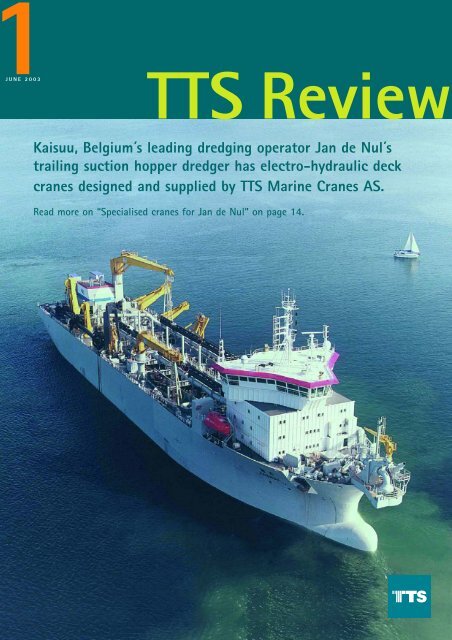


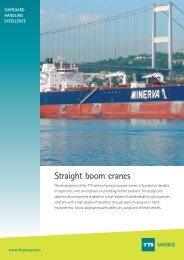
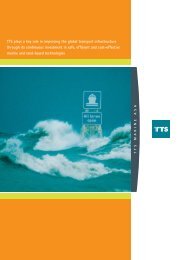
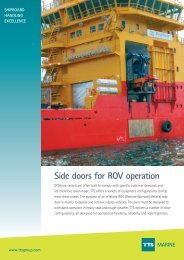
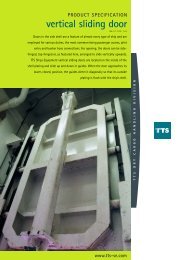
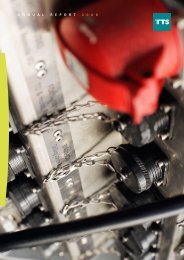


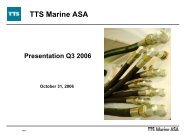
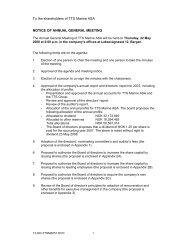
![2012.MasterPresentation_final [Compatibility Mode] - TTS Group ASA](https://img.yumpu.com/4612021/1/190x146/2012masterpresentation-final-compatibility-mode-tts-group-asa.jpg?quality=85)

